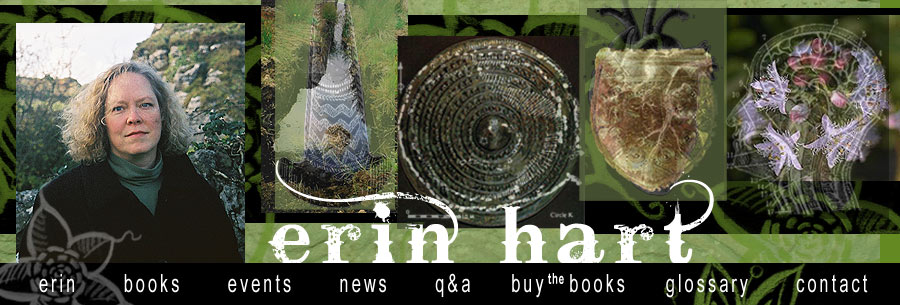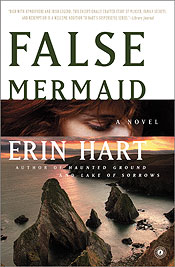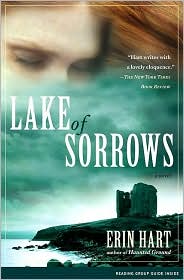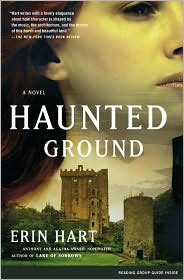One of the things I'm doing (when not working on the new book, of course!) is that I'm coordinating the Literary Corner at the Irish Fair of Minnesota. It's the largest free Irish festival in the nation, drawing crowds of 80,000-100,000 for three days in early August. This year the Fair is August 8-10, and it's held on Harriet Island, across the river from downtown Saint Paul.
This year, in keeping with the 1,000th anniversary of the Battle of Clontarf, the Literary Corner is also focusing on 1,000 years of Irish literature. We're working on getting a calligrapher to speak and demonstrate Irish medieval writing, and we'll also feature 14 Minnesota writers who will talk about and read from their own work, and also about the Irish writers and various literary traditions that have influenced them. And there's going to be a Limerick contest, with winners both Saturday and Sunday. Books by participating authors will be available for purchase and signing.
The Literary Corner will be open Saturday and Sunday, August 9-10, from 11 am. We have a great lineup of talented authors including:
GARY BRUGGEMANN
Gary Bruggemann teaches history at Century and Inver Hills Community Colleges. A lifelong resident of Saint Paul, he has spent the last 35 years researching, writing and teaching Minnesota history. He is the author of numerous works on Saint Paul history, including at least 40 newspaper and magazine articles. In 2012 Gary published Minnesota's Oldest Murder Mystery: The Case Of Edward Phalen, St. Paul's Unsaintly Pioneer, selected as a Midwest Book Awards finalist.
CAROL CONNOLLY
 Carol Connolly, Saint Paul’s Poet Laureate, is the author of All This And More (Nodin Press, 2009). Her first book, Payments Due: Onstage Offstage, Midwest Villages & Voices, now in its fifth printing, was first produced for the stage in Los Angeles and then in Minneapolis, running for two years in each locale. Carol curates a monthly series, Reading by Writers, now in its fourteenth year, to benefit Public Art Saint Paul. She is the recipient of the 2011 Kay Sexton Award, presented annually by the Minnesota Book Awards in recognition of longstanding dedication and outstanding work in fostering books, reading, and literary activity in Minnesota. Carol is a Saint Paul native, has seven children, eleven perfect grandchildren, and one perfect great grandchild.
Carol Connolly, Saint Paul’s Poet Laureate, is the author of All This And More (Nodin Press, 2009). Her first book, Payments Due: Onstage Offstage, Midwest Villages & Voices, now in its fifth printing, was first produced for the stage in Los Angeles and then in Minneapolis, running for two years in each locale. Carol curates a monthly series, Reading by Writers, now in its fourteenth year, to benefit Public Art Saint Paul. She is the recipient of the 2011 Kay Sexton Award, presented annually by the Minnesota Book Awards in recognition of longstanding dedication and outstanding work in fostering books, reading, and literary activity in Minnesota. Carol is a Saint Paul native, has seven children, eleven perfect grandchildren, and one perfect great grandchild.JOHN DINGLEY
 John Dingley grew up on a hill farm in Mid-Wales and now lives in the Twin Cities area of Minnesota. He has been called a renaissance man who has shown a variety of notable talents. John is an animal scientist and his love of nature has involved him in a major role for wildlife reintroduction—he sits on the board of directors for the Raptor Resource Project and the Decorah Eagle Cam. He is also a master glass cutter and engraver as well as being an accomplished stonemason. John’s love of theater has led to performances in a variety of roles, both in Wales and around the Midwest. A noted storyteller and singer, he can occasionally be discovered performing his one-man show, “John Dingley and the Biggest Pack of Lies You Ever Heard.” John also takes a major interest in urban agriculture, sustainable agriculture, and permaculture and has spent time teaching urban young people about the efficient use of gardening and agricultural hand tools. His nonfiction book, Hard Work in Paradise: When All Our Food and Lives Were Organic, will be published soon. The Timeless Cavern: Marged Evans and The Pebbles of Time is John’s first novel, a young-adult fantasy, and he is currently working on the second and third books in the series: Marged Evans and the Pebbles of More Time and Marged Evans and the Pebbles of Distance. For more visit www.timelesscavern.com.
John Dingley grew up on a hill farm in Mid-Wales and now lives in the Twin Cities area of Minnesota. He has been called a renaissance man who has shown a variety of notable talents. John is an animal scientist and his love of nature has involved him in a major role for wildlife reintroduction—he sits on the board of directors for the Raptor Resource Project and the Decorah Eagle Cam. He is also a master glass cutter and engraver as well as being an accomplished stonemason. John’s love of theater has led to performances in a variety of roles, both in Wales and around the Midwest. A noted storyteller and singer, he can occasionally be discovered performing his one-man show, “John Dingley and the Biggest Pack of Lies You Ever Heard.” John also takes a major interest in urban agriculture, sustainable agriculture, and permaculture and has spent time teaching urban young people about the efficient use of gardening and agricultural hand tools. His nonfiction book, Hard Work in Paradise: When All Our Food and Lives Were Organic, will be published soon. The Timeless Cavern: Marged Evans and The Pebbles of Time is John’s first novel, a young-adult fantasy, and he is currently working on the second and third books in the series: Marged Evans and the Pebbles of More Time and Marged Evans and the Pebbles of Distance. For more visit www.timelesscavern.com.MIKE FARICY
 Mike Faricy is a Saint Paul native who splits his time between the saintly city and Dublin, Ireland. He writes books of no redeeming social value… crime fiction, theoretically with a sense of humor and even some romance. His Dev Haskell series, set in Saint Paul, has earned the #1 Amazon slot a half dozen times, and has been nominated for a Minnesota Book Award. His stories don’t deal with government coups, terrorists or international bank conspiracies, but rather the sort of individuals we all know and wisely prefer to keep at a distance. His characters find themselves in situations due to their own bad decisions—but then bad decisions make for interesting tales! Visit his website at www.mikefaricy.com, on Facebook or on Twitter.
Mike Faricy is a Saint Paul native who splits his time between the saintly city and Dublin, Ireland. He writes books of no redeeming social value… crime fiction, theoretically with a sense of humor and even some romance. His Dev Haskell series, set in Saint Paul, has earned the #1 Amazon slot a half dozen times, and has been nominated for a Minnesota Book Award. His stories don’t deal with government coups, terrorists or international bank conspiracies, but rather the sort of individuals we all know and wisely prefer to keep at a distance. His characters find themselves in situations due to their own bad decisions—but then bad decisions make for interesting tales! Visit his website at www.mikefaricy.com, on Facebook or on Twitter.MIKE FINLEY
 Mike Finley, with ancestors in Counties Down and Laois, is author of over one million books, including Skibbereen and A Pox on Your Blessings (with master bread baker Danny Klecko). He grew up in northeast Ohio and is now a Saint Paul writer and poet, videomaker, and performance artist who’s been writing and publishing since 1966. Visit his website at www.mikefinleywriter.com.
Mike Finley, with ancestors in Counties Down and Laois, is author of over one million books, including Skibbereen and A Pox on Your Blessings (with master bread baker Danny Klecko). He grew up in northeast Ohio and is now a Saint Paul writer and poet, videomaker, and performance artist who’s been writing and publishing since 1966. Visit his website at www.mikefinleywriter.com.
ERIN HART
 Erin Hart’s archaeological crime novels are set in the mysterious boglands of Ireland. Her debut, Haunted Ground (2003), won the Friends of American Writers award and Romantic Times' Best First Mystery, was shortlisted for mystery’s prestigious Anthony and Agatha awards, and translated into eleven foreign languages. Lake Of Sorrows (2004) was shortlisted for a Minnesota Book Award, and False Mermaid (2010) was named by ALA/Booklist as one of the Top Ten Crime Novels of 2010. Her latest, The Book Of Killowen (2013), was also a Minnesota Book Award finalist. Erin lives in Saint Paul with her husband, Irish accordion legend Paddy O’Brien, and travels frequently to Ireland, where she leads tours to some of the fascinating places described in her books! For more, visit Erin online atwww.erinhart.com, read her blog, and follow her on Facebook and Twitter.
Erin Hart’s archaeological crime novels are set in the mysterious boglands of Ireland. Her debut, Haunted Ground (2003), won the Friends of American Writers award and Romantic Times' Best First Mystery, was shortlisted for mystery’s prestigious Anthony and Agatha awards, and translated into eleven foreign languages. Lake Of Sorrows (2004) was shortlisted for a Minnesota Book Award, and False Mermaid (2010) was named by ALA/Booklist as one of the Top Ten Crime Novels of 2010. Her latest, The Book Of Killowen (2013), was also a Minnesota Book Award finalist. Erin lives in Saint Paul with her husband, Irish accordion legend Paddy O’Brien, and travels frequently to Ireland, where she leads tours to some of the fascinating places described in her books! For more, visit Erin online atwww.erinhart.com, read her blog, and follow her on Facebook and Twitter.LAURIE HERTZEL
 Laurie Hertzel is Senior Editor/Books at the Minneapolis Star Tribune, where she has worked since 1996. Previously, she was a writer and editor at Minnesota Monthlymagazine and at the Duluth News-Tribune. She is the author of a memoir, News to Me: Adventures of an Accidental Journalist (University of Minnesota Press, 2010), winner of a 2011 Minnesota Book Award, and co-author of They Took My Father: Finnish-Americans In Stalin's Russia (with Mayme Sevander, University of Minnesota Press, 2004). She has received state and national awards for her short fiction, magazine articles and newspaper stories. She lives in Saint Paul. Visit her online at www.lauriehertzel.com or follow her blog.
Laurie Hertzel is Senior Editor/Books at the Minneapolis Star Tribune, where she has worked since 1996. Previously, she was a writer and editor at Minnesota Monthlymagazine and at the Duluth News-Tribune. She is the author of a memoir, News to Me: Adventures of an Accidental Journalist (University of Minnesota Press, 2010), winner of a 2011 Minnesota Book Award, and co-author of They Took My Father: Finnish-Americans In Stalin's Russia (with Mayme Sevander, University of Minnesota Press, 2004). She has received state and national awards for her short fiction, magazine articles and newspaper stories. She lives in Saint Paul. Visit her online at www.lauriehertzel.com or follow her blog.AMANDA HUGHES
 All her life Amanda Hughes has been a "Walter Mitty," spending more time in heroic daydreams than in the real world. At last she found an outlet: writing adventures about audacious women in the 18th century. Her best-selling novel, Beyond the Cliffs of Kerry was published in 2002; The Pride of the King released in 2011, and The Sword of the Banshee in 2013. Amanda is a graduate of the University of Minnesota and when she isn't off tilting at windmills, she lives and writes in Saint Paul. Visit her online at www.amandahughesauthor.com and read her blog.
All her life Amanda Hughes has been a "Walter Mitty," spending more time in heroic daydreams than in the real world. At last she found an outlet: writing adventures about audacious women in the 18th century. Her best-selling novel, Beyond the Cliffs of Kerry was published in 2002; The Pride of the King released in 2011, and The Sword of the Banshee in 2013. Amanda is a graduate of the University of Minnesota and when she isn't off tilting at windmills, she lives and writes in Saint Paul. Visit her online at www.amandahughesauthor.com and read her blog.
TRACIE LOEFFLER DONAGHY
 In 2001, Tracie Loeffler Donaghy went on a vacation to Ireland and came home married to an Irishman. Her memoir, An American in Belfast, is a personal journey into a darker side of Ireland, one of paramilitaries, bomb scares, and sectarian violence. She has been a guest speaker on local radio and at various literary events, reading from her memoir and discussing her experiences of life in Northern Ireland. Tracie also regularly organizes and hosts Irish pub-style literary readings in the Twin Cities, featuring writers and poets from the local Irish community. She teaches writing and has a master’s degree in Creative Writing from Hamline University.
In 2001, Tracie Loeffler Donaghy went on a vacation to Ireland and came home married to an Irishman. Her memoir, An American in Belfast, is a personal journey into a darker side of Ireland, one of paramilitaries, bomb scares, and sectarian violence. She has been a guest speaker on local radio and at various literary events, reading from her memoir and discussing her experiences of life in Northern Ireland. Tracie also regularly organizes and hosts Irish pub-style literary readings in the Twin Cities, featuring writers and poets from the local Irish community. She teaches writing and has a master’s degree in Creative Writing from Hamline University.NORA MURPHY
 Nora Murphy is a fifth generation Irish-American Minnesotan whose great-grandfather cut and laid granite for the Saint Paul Cathedral. Author of essays, poems, and nonfiction books, Nora fell in love with Saint Brigid in the Cathedral’s shrine of nations and pays tribute to the great saint in her memoir, Knitting The Threads Of Time: Casting Back To The Heart Of Our Craft.
Nora Murphy is a fifth generation Irish-American Minnesotan whose great-grandfather cut and laid granite for the Saint Paul Cathedral. Author of essays, poems, and nonfiction books, Nora fell in love with Saint Brigid in the Cathedral’s shrine of nations and pays tribute to the great saint in her memoir, Knitting The Threads Of Time: Casting Back To The Heart Of Our Craft.PADDY O’BRIEN
 Paddy O’Brien is an Irish traditional musician and noted tune collector. In 2012, The Road From Castlebarnagh, his account of growing up as a musician in rural Ireland, was published by Orpen Press in Dublin. He has also published a number of poems in a series about the older generation of Irish traditional musicians, and three volumes of the Paddy O’Brien Tune Collection, comprising 1,500 tunes and stories from his vast repertoire. Paddy's encyclopedic knowledge of Irish music is legendary. In a career spanning more than 50 years, he has collected more than 3,000 compositions—jigs, reels, hornpipes, airs, and marches, including many rare and unusual tunes. Paddy is a master of the two-row button accordion and in addition to several All-Ireland titles, he was named Ireland's Traditional Composer of the Year at the Gradam Ceoil Irish Music Awards in 2012. He lives in Saint Paul with his wife, mystery novelist Erin Hart. Visit his website at www.paddyobrien.net, on Facebookor on Twitter.
Paddy O’Brien is an Irish traditional musician and noted tune collector. In 2012, The Road From Castlebarnagh, his account of growing up as a musician in rural Ireland, was published by Orpen Press in Dublin. He has also published a number of poems in a series about the older generation of Irish traditional musicians, and three volumes of the Paddy O’Brien Tune Collection, comprising 1,500 tunes and stories from his vast repertoire. Paddy's encyclopedic knowledge of Irish music is legendary. In a career spanning more than 50 years, he has collected more than 3,000 compositions—jigs, reels, hornpipes, airs, and marches, including many rare and unusual tunes. Paddy is a master of the two-row button accordion and in addition to several All-Ireland titles, he was named Ireland's Traditional Composer of the Year at the Gradam Ceoil Irish Music Awards in 2012. He lives in Saint Paul with his wife, mystery novelist Erin Hart. Visit his website at www.paddyobrien.net, on Facebookor on Twitter.PATRICK O’DONNELL
 Originally from Dublin, Patrick O’Donnell is a college teacher, theater director, literary historian, and author. He teaches writing and literature (with a focus on Shakespeare and James Joyce) at Normandale Community College. He has been the Artistic Director of Cracked Lookingglass Theatre, Titanic Players, and the Celtic Players. He has written such plays as Vampire Moonshine, I’m Switzerland, Dickens in Dublin, and has created a stage adaptation of Joyce’s novel, Ulysses. Patrick’s focus at present is creative nonfiction with an emphasis on the career of Sir Tyrone Guthrie. He has published work in the Irish scholarly journal New Hibernia Review, The St. Paul Almanac, the online newspaper The Daily Planet, and The Irish Gazette, and has contributed an essay on the Guthrie’s Theater’s Irish roots to Polly Grose’s anthology The Guthrie Theater: The First Fifty Years. Patrick also writes short fiction based on Dublin city and its imagined alternative ancient histories. He is married and lives in Saint Paul with his wife and three children.
Originally from Dublin, Patrick O’Donnell is a college teacher, theater director, literary historian, and author. He teaches writing and literature (with a focus on Shakespeare and James Joyce) at Normandale Community College. He has been the Artistic Director of Cracked Lookingglass Theatre, Titanic Players, and the Celtic Players. He has written such plays as Vampire Moonshine, I’m Switzerland, Dickens in Dublin, and has created a stage adaptation of Joyce’s novel, Ulysses. Patrick’s focus at present is creative nonfiction with an emphasis on the career of Sir Tyrone Guthrie. He has published work in the Irish scholarly journal New Hibernia Review, The St. Paul Almanac, the online newspaper The Daily Planet, and The Irish Gazette, and has contributed an essay on the Guthrie’s Theater’s Irish roots to Polly Grose’s anthology The Guthrie Theater: The First Fifty Years. Patrick also writes short fiction based on Dublin city and its imagined alternative ancient histories. He is married and lives in Saint Paul with his wife and three children.DAVE PAGE
 Dave Page has written and edited several books on the Irish-Catholic writer F. Scott Fitzgerald and his connection to Minnesota, including The Thoughtbook of F. Scott Fitzgerald: A Secret Boyhood Diary, a journal by the young Saint Paul writer. Dave is a member of the International F. Scott Fitzgerald Society and a board member of Fitzgerald in St. Paul, a nonprofit seeking to promote Fitzgerald in his birthplace. Dave currently teaches writing at Inver Hills Community College.
Dave Page has written and edited several books on the Irish-Catholic writer F. Scott Fitzgerald and his connection to Minnesota, including The Thoughtbook of F. Scott Fitzgerald: A Secret Boyhood Diary, a journal by the young Saint Paul writer. Dave is a member of the International F. Scott Fitzgerald Society and a board member of Fitzgerald in St. Paul, a nonprofit seeking to promote Fitzgerald in his birthplace. Dave currently teaches writing at Inver Hills Community College.
JIM ROGERS
 Jim Rogers is the author of an essay collection, Northern Orchards: Places Near the Dead (2014) and a poetry chapbook, Sundogs (2006). He’s also published many scholarly articles on Irish America, and edited two books on the topic: After the Flood: Irish America, 1945-1960 (2009) and Extended Family: Essays on Being Irish American (2013). Jim edits New Hibernia Review, a journal of Irish Studies published by the university of Saint Thomas, and is a past president of the American Conference for Irish Studies. He has twice been listed as a “notable” in the annual Best American Essays collections.
Jim Rogers is the author of an essay collection, Northern Orchards: Places Near the Dead (2014) and a poetry chapbook, Sundogs (2006). He’s also published many scholarly articles on Irish America, and edited two books on the topic: After the Flood: Irish America, 1945-1960 (2009) and Extended Family: Essays on Being Irish American (2013). Jim edits New Hibernia Review, a journal of Irish Studies published by the university of Saint Thomas, and is a past president of the American Conference for Irish Studies. He has twice been listed as a “notable” in the annual Best American Essays collections.









